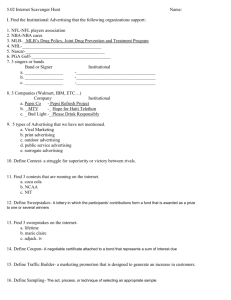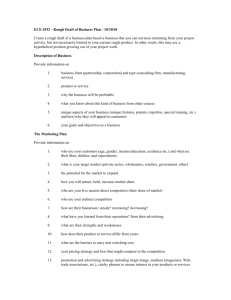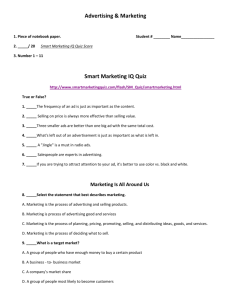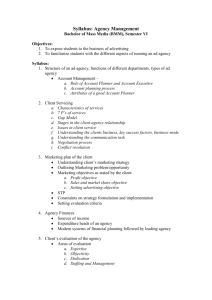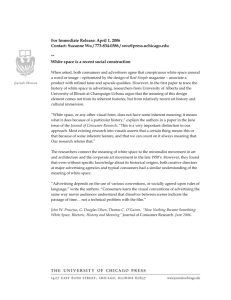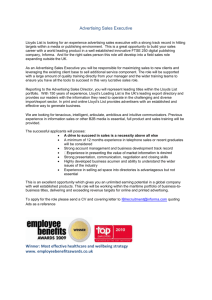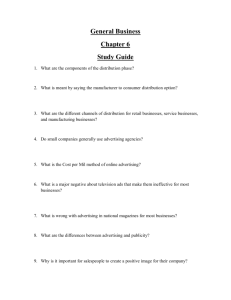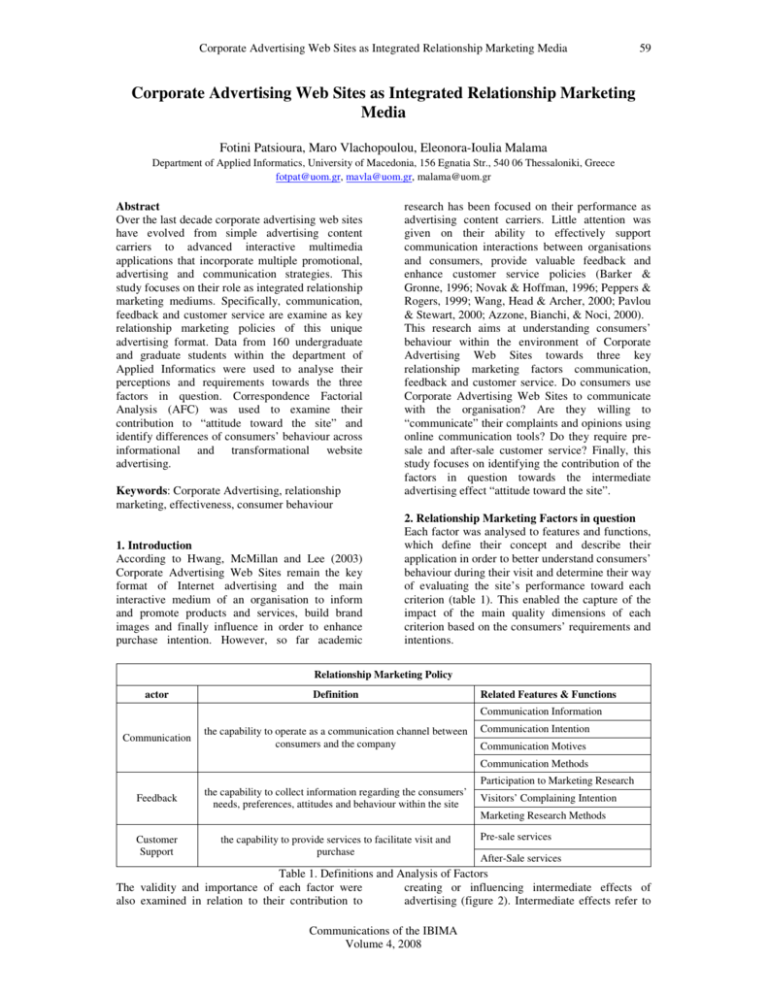
Corporate Advertising Web Sites as Integrated Relationship Marketing Media
59
Corporate Advertising Web Sites as Integrated Relationship Marketing
Media
Fotini Patsioura, Maro Vlachopoulou, Eleonora-Ioulia Malama
Department of Applied Informatics, University of Macedonia, 156 Egnatia Str., 540 06 Thessaloniki, Greece
fotpat@uom.gr, mavla@uom.gr, malama@uom.gr
Abstract
Over the last decade corporate advertising web sites
have evolved from simple advertising content
carriers to advanced interactive multimedia
applications that incorporate multiple promotional,
advertising and communication strategies. This
study focuses on their role as integrated relationship
marketing mediums. Specifically, communication,
feedback and customer service are examine as key
relationship marketing policies of this unique
advertising format. Data from 160 undergraduate
and graduate students within the department of
Applied Informatics were used to analyse their
perceptions and requirements towards the three
factors in question. Correspondence Factorial
Analysis (AFC) was used to examine their
contribution to “attitude toward the site” and
identify differences of consumers’ behaviour across
informational and transformational website
advertising.
Keywords: Corporate Advertising, relationship
marketing, effectiveness, consumer behaviour
1. Introduction
According to Hwang, McMillan and Lee (2003)
Corporate Advertising Web Sites remain the key
format of Internet advertising and the main
interactive medium of an organisation to inform
and promote products and services, build brand
images and finally influence in order to enhance
purchase intention. However, so far academic
research has been focused on their performance as
advertising content carriers. Little attention was
given on their ability to effectively support
communication interactions between organisations
and consumers, provide valuable feedback and
enhance customer service policies (Barker &
Gronne, 1996; Novak & Hoffman, 1996; Peppers &
Rogers, 1999; Wang, Head & Archer, 2000; Pavlou
& Stewart, 2000; Azzone, Bianchi, & Noci, 2000).
This research aims at understanding consumers’
behaviour within the environment of Corporate
Advertising Web Sites towards three key
relationship marketing factors communication,
feedback and customer service. Do consumers use
Corporate Advertising Web Sites to communicate
with the organisation? Are they willing to
“communicate” their complaints and opinions using
online communication tools? Do they require presale and after-sale customer service? Finally, this
study focuses on identifying the contribution of the
factors in question towards the intermediate
advertising effect “attitude toward the site”.
2. Relationship Marketing Factors in question
Each factor was analysed to features and functions,
which define their concept and describe their
application in order to better understand consumers’
behaviour during their visit and determine their way
of evaluating the site’s performance toward each
criterion (table 1). This enabled the capture of the
impact of the main quality dimensions of each
criterion based on the consumers’ requirements and
intentions.
Relationship Marketing Policy
actor
Definition
Related Features & Functions
Communication Information
Communication
the capability to operate as a communication channel between
consumers and the company
Communication Intention
Communication Motives
Communication Methods
Participation to Marketing Research
Feedback
the capability to collect information regarding the consumers’
needs, preferences, attitudes and behaviour within the site
Visitors’ Complaining Intention
Marketing Research Methods
Customer
Support
the capability to provide services to facilitate visit and
purchase
Pre-sale services
After-Sale services
Table 1. Definitions and Analysis of Factors
The validity and importance of each factor were
creating or influencing intermediate effects of
also examined in relation to their contribution to
advertising (figure 2). Intermediate effects refer to
Communications of the IBIMA
Volume 4, 2008
Fotini Patsioura, Maro Vlachopoulou and Eleonora-Ioulia Malama
60
Relationship Marketing Policy
reactions and actions that represent a positive or
negative response to the advertising web site such
as: “attitude toward the site” (Chen & Wells, 1999,
Bruner & Kumar, 2000) which was measured in
terms of “revisiting intention”, “word of mouth
intention” and “overall opinion of the site”. It
should be mentioned that so far, effectiveness
measurements for Corporate Advertising Web Sites
were based on the analysis of variables and factors
strictly related to advertising objectives (Ducoffe,
1996, Chen & Wells, 1999) or factors closely
related to the medium’s characteristics such as
interactivity and navigation (Novak & Hoffman,
1997; Ghose & Dou, 1998; Coyle & Thorson, 2001,
Liu & Shrum, 2002, Macias, 2003).
A ttitu d e to w a r d th e site
C o m m u n ic a tio n
Feedback
C u s to m e r S u p p o rt
O v e ra ll O p in io n
R e v is itin g In te n tio n
“ W o r d o f M o u th ” in te n tio n
Figure1. Relationship Marketing Factors towards “attitude towards the site”
3. Methodology
Data were collected through a questionnaire-based
survey. Real domain web sites were chosen as
advertising stimulus and representatives of the two
main categories of web site advertising
(informational and transformational advertising)
(table2). This was necessary in order to address
issues like product involvement impact and hedonic
and utilitarian dimensions towards consumers’
behaviour and advertising effectiveness based on
prior research (Rossiter & Bellman, 1999; Rodgers,
2002; Zhou & Bao, 2002; Hwang et al, 2003 ).
Site A
Site B
Company
Greek
Multinational
Site Type
Brand Web Site
Products
Chocolate products
High Technology products
Product type
low-involvement
high-involvement
transformational
informational
to “Entertain”
to “Inform” and provide
service
Communication / Message Strategy
Main Objective
Corporate Web Site
Table 2. Advertising Stimulus
A total of 160 undergraduate and graduate students
within the department of Applied Informatics of
University of Macedonia participated in the survey.
A student sample was selected opposed to general
population based on their predictive and analytical
validity of consumer behaviour analysis in
traditional and Internet marketing and advertising
research under specific circumstances (Hampton,
1979; Yavas, 1994; Rosner, 1996; Korgaonkar &
Wolin, 1999; Danaher & Mullarkey, 2003).
Subjects were between the ages of 21-30 and
matched the average profile of Greek Internet User
& Shoppers (National Statistic Service of Greece,
2005). All participants stated to be familiar with
both brands of the selected web sites.
The survey took place at a university’s computer
laboratory. Participants were divided in groups of
four and were randomly assigned to browse for at
least five minutes one of the two web sites (80
participants review site A and 80 participants
Communications of the IBIMA
Volume 4, 2008
Corporate Advertising Web Sites as Integrated Relationship Marketing Media
review site B). After their brief exposure to the
specific site, participants were asked to fill in the
same questionnaire containing 37 questions. The
participants were supervised in order to ensure that
each subject completed the survey at the indicated
time and way, and handed in a qualified
questionnaire.
4. Statistical Analysis
Descriptive Statistics and Correspondence Factorial
Analysis (AFC) (Papadimitiou, Hadjikonstantinou,
Drymbetas, & Karagiannis, 1998, Papadimitriou &
Koutsoupias, 2000; Markos, Menexes &
Papadimitiou, 2006; Papadimitriou, 2007) were
used for the questionnaires’ statistical analysis. The
AFC was run using CHIC software.
In order to define the importance of contribution for
each factor, COR and CTR (Relative and Absolute
Contribution) indices were used that reproduced
factorial axes and first factorial planes (formed by
the two first factorial axes). The AFC was applied
to selected Burt Tables (Generalised Contingency
Tables) in order to identify differences across
subjects’ perceptions and intentions that were
exposed to either informational or transformational
advertising stimulus. Also, the method enabled the
examination and identification of the three factors’
relation and contribution towards to the depended
variable of “attitude toward the site”.
5. Results
Descriptive Statistics
The outcomes revealed significant dimensions of
the participants’ behaviour based on their actions,
activities and preferences during their visit. General
assumptions were drawn in relation to the three
factors in question by analysing results
independently to the website’s category (upon the
whole sample of 160 subjects).
Regarding “communication”:
25% of the subjects stated as most
valuable and important information within the
website, communication information. Practically,
this could indicate that in consumers’ mind a
corporate advertising website is considered to be a
way to directly communicate with the company
27% of the respondents “communicated”
with the company during their visit using
communication practices and tools that required
61
limited time and effort (such as answering by
“clicking” on multiple choice predefined
questions or filling in a form). This is an important
percentage taking into account a main limitation
of this research, which is the lack of specific
visiting motives by the subjects
92% of the subjects reported that would
use the website to communicate with the company
in the future
74% of the subjects stated that would
select interactive communication channels such as
email, real-time communication, online forms
over traditional ones (free-toll telephone) to
communicate with the company
With regards to “feedback”
64% of the respondents stated that would
fill in a questionnaire provided on the website as
part of a marketing research conduction by the
company
also 37% reported that participated in the
past in similar research methods when visiting ecommerce and advertising web sites
92% of the subjects stated that the website
should have a “complaining form” and 89% stated
that they would fill in a complaining form to
communicate problems and dissatisfaction.
Finally, regarding “customer service”:
72% of the subjects stated the importance
of problem solving policies apart from
communication policies
and 67% of the respondents supported the
idea of pre-sale services (such as problem solving
and gathering information) being more important
than after sale services such as return police
AFC Results
The application of the AFC method provided a
graphical
representation
of
the
main
correspondences and differences of the variables
examined across the two groups of subjects.
Specifically, it is evident from the results of AFC
application that the participants’ requirements and
beliefs should not be studied independently to the
website’s communication and advertising message
strategy, which is mainly formed by the product
category. Figure 2 and 3 provide some of the results
produced by the application of the AFC method for
the factors in question and illustrates their graphical
representation (first factorial planes).
Communications of the IBIMA
Volume 4, 2008
62
Fotini Patsioura, Maro Vlachopoulou and Eleonora-Ioulia Malama
I would communicate
in order to state my
opinion on the
products or the
website
I would fill in a a
questionnaire
provided
I believe that the
Site should
provide “real-time
communication”
Web Site A
I believe that the
Site should not
provide “real-time
communication”
I would communicate
in order to gather
more product
information
I would fill in a
complaining form
Web Site B
I would communicate
in order to gather
more information on
the organisation
Factorial Plane 1x2
Figure 2. AFC Application on “communication” and “feedback” factors
Problem Solving
Web Site A
Aesthetics
Navigation
Web Site B
Advertising
Content
Interactivity_ Entertainment
Interactivity_ Real Time
Communication
Communication
Customer Service
Advertising Content
Medium Characteristics
Relationship Marketing Policy
Figure 3 AFC Application on “Overall Opinion” (Intermediate Advertising Effect)
Specifically, the outcomes revealed significant
differences regarding consumers’ requirements and
intentions:
communication motives differ across
subjects that visited “Brand Image” Web Site (A)
and those visited “Informative” Web Site (B).
Specifically, subjects’ motives that were exposed
to Web Site A are related to feedback dimensions
(“communicate” their opinion about the products
and the Web Site), while subjects’ exposed to
Web Site B stated as main communication
motives the gathering of product information
Communications of the IBIMA
Volume 4, 2008
Corporate Advertising Web Sites as Integrated Relationship Marketing Media
pre-sale and after-sale customer service are
more important for subjects exposed to Web Site
B.
other qualitative factors incorporated in the
effectiveness measures such as advertising
content, navigation, aesthetics and interactivity
contributed more “attitude towards the site”
Regarding the contribution of the factors in
question to the depended variable:
marketing relationship factors contribute
differently with the reference of the two types of
Advertising Web Sites
communication and feedback contribute
the least to “attitude toward the site” because they
are considered to be implicit processes by the
participants
customer service dimensions (such as
problem solving policies, return policies, real time
communication) contribute the most “to attitude
toward the site” for the informative web site
In the aggregate, the results provide insight on the
participants; behaviour and identify how it is
differentiated across the two main website
advertising types.
6. Discussion
This study supports the idea that Corporate
Advertising Web Sites are established not only to
communicate advertising content but also to meet
specific
relationship
marketing
objectives.
Communication, feedback and customer service
Three key relationship were examined and analysed
as key relationship marketing factors, based on
consumers’ behaviour. The data provided insights
into the subjects’ perceptions and requirements
regarding specific features and dimensions applied
in corporate advertising web sites to support
relationship marketing policies.
Another contribution concerns the identification of
their relation to “attitude toward the site”
effectiveness indicator. Primary research results
advocate that relationship marketing factors are
both contributors to intermediate advertising effects
under specific circumstances. In addition, the
factors in question differ in contribution across
different types of Corporate Advertising Web Sites.
The results involve important implications for the
practitioners as the study demonstrated consumers’
use and intended use regarding communication and
feedback features and policies incorporated by
Corporate Advertising Web Sites. It is evident that
subjects feel comfortable to communicate their
opinion and complaints to the company through the
Web Site using specific methods. In addition, their
requirements regarding pre-sale and after-sale
customer service supports the role of Corporate
Advertising Web Sites as integrated marketing
tools.
63
References
Azzone, G., Bianchi, R. & Noci, G., (2000). The
Company’s
Web
Site:
Different
Configurations,
evolutionary
path.
Management Decision, vol.38, no.7, pp.470479
Barker, C. & Groenne, P., (1996), “Advertising on
the World Wide Web”, Master Thesis,
Copenhagen Business School, Ανάκτηση
20/06/2001
από
http://www.samkurser.dk/advertising/researc
h.htm
Bruner, G. & Kumar, A. (2000). Web Commercials
and Advertising Hierarchy-of-Effects.
Journal of Advertising Research, 40 (2), 3542
Chen, Q. & Wells, D. (1999). Attitude toward the
Site. Journal of Advertising Research, 39 (5),
27-37
Coyle, J. & Thorson, E. (2001). The Effects of
Progressive Levels of Interactivity and
Vividness in Web Marketing Web Sites.
Journal of Advertising, 30 (3), 65-77
Danaher, P., & Mullarkey, G. (2003). Factors
affecting online Advertising Recall: A Study
of Students. Journal of Advertising
Research, 41(4), 252-267
Ducoffe, R. (1996).Advertising Value and
Advertising on the Web. Journal of
Advertising Research, 36(5), 21-35
Ghose, S. & Dou, W. (1998). Interactive Functions
and Their Impact on The Appeal of Internet
Presence Sites. Journal of Advertising
Research, 38 (2), 29-43
Hampton, G. (1979). Students as Subjects in
International Behavioural Studies. Journal of
International Business Studies, 10 (2), 94-96
Hoffman, D.L. & Novak, T.P. (1996). Marketing in
Hypermedia Computer-Mediated
Environments: Conceptual Foundations.
Journal of Marketing, 60, 50-68
Hwang, J., McMillan, S. & Lee, G. (2003).
Corporate Web Sites as Advertising: An
Analysis of Function, Audience, and
Message Strategy. Journal of Interactive
Advertising, 3(2), 12-32
Korgaonkar, P. & Wolin, L. (1999). A Multivariate
Analysis of Web Usage. Journal of
Advertising Research, 39(2), 53-68
Liu, Y. & Shrum, L. (2002). What is Interactivity
and is it Always Such a Good Thing?
Implications of Definition, Person, and
Situation for the Influence of Interactivity on
Advertising Effectiveness. Journal of
Advertising, 31 (4), 53-64
Macias, W. (2003). A Beginning Look at the
Effects of Interactivity, Product Involvement
and Web Experience on Comprehension:
Brand Web Sites as Interactive Advertising.
Communications of the IBIMA
Volume 4, 2008
64
Fotini Patsioura, Maro Vlachopoulou and Eleonora-Ioulia Malama
Journal of Current Issues and Research in
Advertising, 25 (2), 31-44.
Markos, A., Menexes, G. & Papadimitiou, I.
(2006). H παραγοντική Ανάλυση µέσω του
Λογισµικού C.HI.C Analysis [The
Correspondence Factorial Analysis (AFC)
with the Utilization of C.HI.C Analysis
Software]. Paper Presented in19th
Panhellenic Conference in Statistics of
Greek Statistical Institute. Kastoria, Greece
2006 (in Greek)
Novak, T. & Hoffman, D. (1997). New Metrics for
New Media: Toward the Development of
Web Measurement Standards. World Wide
Web Journal, 2 (1), 213-246
National Statistical Service of Greece (2005).
National Survey Regarding the Use of
Information Technology and
Communication. General Secretariat of
National Statistical Service of Greece.
Retrieved May 2006 from
http://www.statistics.gr/
Papadimitriou, I. (2007). Data Analysis: Factorial
Correspondence Analysis, Hierarchical
Cluster Analysis and other Methods.
Topothito. Athens, 1st edition.
Papadimitriou,
I.,
Hadjikonstantinou,
G.,
Drymbetas, E. and Karagiannis, S. (1998).
La convergence Europeéne. L' application de
la methode de l' A.F.C. sur l' evolution des
principales variables monetaires et rèelles
des pays–membres de l' union Europèene. In
Proc. 47eme Journées sur l' Aide
Multicritere á la Dècision. Thessaloniki,
1998
Papadimitriou, I. & Koutsoupias, N. (2000).
Correspondence Factorial Analysis (AFC)
Software. In the proceedings of the13nd
Panhellenic Conference in Statistics of
Greek Statistical Institute (pp.417-426).
Florina, Greece
Pavlou, P. & Stewart, D. (2000). Measuring the
Effects & Effectiveness of Interactive
Advertising: A Research Agenda. Journal of
Interactive Advertising, 1(1), 5-25
Peppers, D., Rogers, M. (1999), The One to One
Manager: Real-World Lessons in Customer
Relationship Management. Doubleday, New
York, NY
Rodgers, S. (2002). The Interactive Advertising
Model Tested: The Role of Internet Motives
in Ad Processing. Journal of Interactive
Advertising, 2 (2), 27-43. Available
at:jiard.org/vo2/no2/rodgers
Rosner, H., (1996), “Trapping Students in the
Web”. Brandweek, vol.37 (16), 50-52
Rossiter, J. &Bellman, S. (1999). A Proposed
Model for Explaining and Measuring Web
Ad Effectiveness. Journal of Current Issues
and Research in Advertising, 21(1), 13-31
Yavas, U. (1994). Research Note: Students as
Subjects in Advertising and Marketing
Research. International Marketing Review,
11(4), 35-43
Wang, F., Head, M. & Archer, N., (2000). A
Relationship-Building Model for Web retail
Marketplace. Internet Research: Electronic
Networking Applications & Policy, 10(5),
374-384
Zhou, Z. & Bao, Y. (2002). Users’ Attitudes toward
Web Advertising: Effects of Internet
Motivation and Internet Ability. Advances in
Consumer Research, 29, 71-78
Copyright © 2008 by the International Business
Information Management Association (IBIMA). All
rights reserved. Authors retain copyright for their
manuscripts and provide this journal with a publication
permission agreement as a part of IBIMA copyright
agreement. IBIMA may not necessarily agree with the
content of the manuscript. The content and proofreading
of this manuscript as well as and any errors are the sole
responsibility of its author(s). No part or all of this work
should be copied or reproduced in digital, hard, or any
other format for commercial use without written
permission. To purchase reprints of this article please email: admin@ibima.org.
Communications of the IBIMA
Volume 4, 2008

